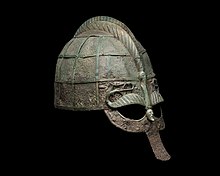Vendel Period
This articleneeds additional citations forverification.(December 2020) |
| History ofSweden |
|---|
 |
| Timeline |
|
|


InSwedish prehistory,theVendel Period(Swedish:Vendeltiden;c. 540–790 AD) appears between theMigration Periodand theViking Age.The name is taken from the rich boat inhumation cemetery atVendelparish church,Uppland.Unlike the preceding and succeeding eras, the Vendel Period left very few precious metal artifacts orrunic inscriptions.Instead, it is extremely rich inanimal arton copper-alloy objects. It is also known forguldgubbar,tiny em Boss ed gold foil images, and elaborate helmets with em Boss ed decoration similar to the one found atSutton Hooin England.[1]
During the period, Swedish expeditions began to explore the waterways of territories which later becameRussia,Ukraine,andBelarus.TheElder Futharkwriting system was abandoned in favor of theYounger Futhark,virtually simultaneously over the whole of Scandinavia. Somerunestonessurvive, most notably those atRökandSparlösa,both fromc. 800.Other written sources are few and hard to interpret: a few Icelandic sagas, the tale ofBeowulf,and accounts from some southern European writers. Earlier Swedish historians tried to make use of these to create a coherent history, but this effort has largely been abandoned, and the period is now mostly studied by archaeologists.[2]
Background[edit]
The Germanic Iron Age is divided into the Early Germanic Iron Age (EGIA) and the Late Germanic Iron Age (LGIA). It is particularly for Sweden that the late Germanic iron age spanning between 550–800 is called the Vendel era. In Norway and Finland it is more common to refer to the period as theMerovingianAge, while the Danish refer to it as the Younger Germanic Iron Age.
The late Germanic Iron Age begins with thefall of the Western Roman Empireand the rise of the Gothic kingdoms in Europe, later replaced by theFranks,theLombardsand theAvar Khaganate.After the Western Roman Empire fell, gold became scarce and Scandinavians began to make objects of gilded bronze, with decorative figures of interlacing animals. During the early Germanic Iron Age, decorations tended to be representational; the animal figures were drawn in more basic forms. In the later Germanic Iron Age, artistic styles became more abstract, symbolic, and intricate, including figures with interlaced shapes and limbs.
The upheaval in Europe appears to have lessened somewhat due to the gradual cessation of theGothic Wars.Emperor Justinian'sEternal Peace (532)with the ShahanshahKhosrau IofIranas well as the Byzantine reconquest of the Italian peninsula with the capitulation of theGothssouth of thePo river(555), the completion of the Byzantine reconquest (562) may be seen in context of what has been described as the Vendel period. TheMerovingianshave united theGaulish Romansand theBelgae.TheFranksestablishing the Merovingan dynasty as "Kings of the Franks" (since509).
InUppland,in what today is the east-central part of Sweden,Old Uppsalawas probably the centre of religious and political life. It had both a well-knownsacred groveand greatRoyal Mounds.
Burial customs[edit]
Several areas with rich burial gifts have been found, including well-preserved boat inhumation graves atVendelandValsgärde,and tumuli atGamla Uppsala.These were used for several generations.
Some of the riches were probably acquired through the control of mining districts and the production of iron. The rulers had troops of mounted elite warriors with costly armour. Graves of mounted warriors have been found with stirrups and saddle ornaments of birds of prey in gilded bronze with encrusted garnets.
Rich grave goods indicate a royal or high status burial. For example chess pieces made ofivoryin theRomanstyle are found in the western grave, and buttons made ofgoldand three Middle Easterncameoshave also been found along withFrankishclothes made of gold thread.[3]
Games were popular, as is shown in finds oftafl games,including pawns and dice.
TheSutton Hoo helmetclosely resembles helmets found in Gamla Uppsala, Vendel and Valsgärde, sharing elements such asboar imageryandpressblechfoil decoration, showing that theAnglo-Saxonelite had extensive contacts with Swedish elite.[4]
Written sources[edit]
Mounted elite warriors are mentioned in the work of the 6th century Goth scholarJordanes,who wrote that the Swedes had the best horses beside theThuringians.They also echo much later in the sagas, where kingAdilsis always described as fighting on horseback (both againstÁliandHrólf Kraki).Snorri Sturlusonwrote that Adils had the best horses of his days. The epic ofBeowulfalso describes legendary tales about the Swedish Vendel times, including great wars called theSwedish-Geatish warsbetween the Swedish house ofScylflingand theGeatishhouse ofWulfling.[5]
Due toBeowulfandNorse sagaspossibly independently mentioning some of theSwedish legendaryroyals some of them could be historical. Geats could have been a part of theAnglo-Saxon settlement of Britain.They probably did not have any major role but could have been described by English sources asJutes.[6]The Wulfling dynasty inGeatlandmight be related to the house ofWuffingas.[7]
Timeline of Swedish history[edit]

See also[edit]
References[edit]
- ^Harrison (2009), p. 68
- ^Harrison (2009), pp. 21-23
- ^Västhögen."Västhögen".Arkeologi Gamla Uppsala(in Swedish). Archived fromthe originalon 2 December 2021.Retrieved6 January2021.
- ^Bruce-Mitford, Rupert (1974). Aspects of Anglo-Saxon Archaeology: Sutton Hoo and Other Discoveries. London: Victor Gollancz.
- ^"The Project Gutenberg eBook of Beowulf: An Anglo-Saxon Epic Poem".
- ^Schütte, Gudmund (1912)."The Geats of Beowulf".The Journal of English and Germanic Philology.11(4): 574–602.JSTOR27700194.
- ^Newton, Sam (2004). The Origins of Beowulf: And the Pre-Viking Kingdom of East Anglia. Boydell & Brewer.ISBN978-0-85991-472-7.
Sources[edit]
- Jesch, Judith (ed.) (2012).The Scandinavians from the Vendel Period to the Tenth Century: An Ethnographic Perspective,Boydell Press, 2012.ISBN9781843837282
- Harrison, Dick.Sveriges historia: 600–1350.Norstedts. Stockholm: 2009.ISBN9789113023779
- Hyenstrand, Åke.Lejonet, draken och korset. Sverige 500–1000[The Lion, the Dragon, and the Cross. Sweden 500–1000]. Enskede: TBP, 2002.
